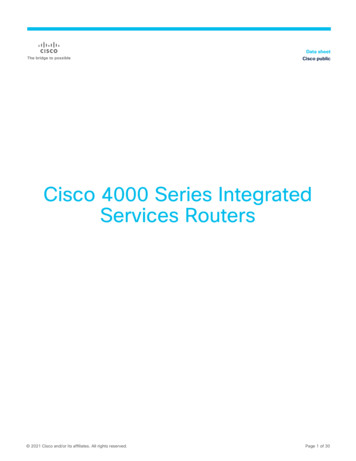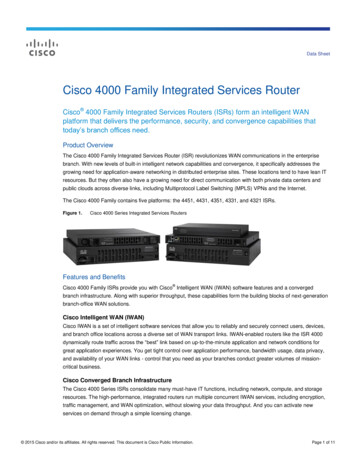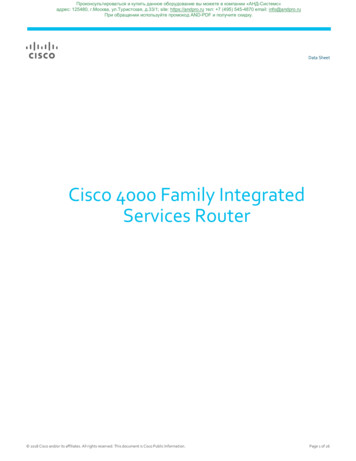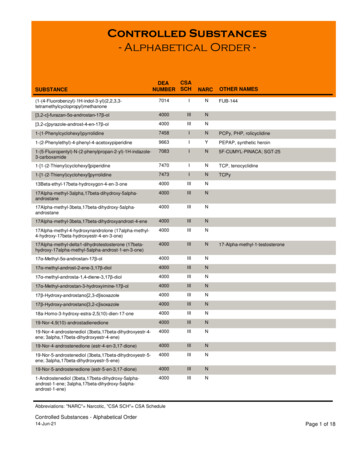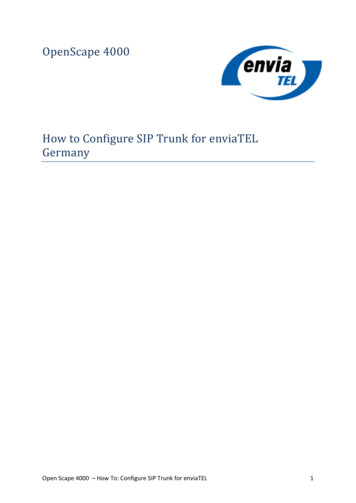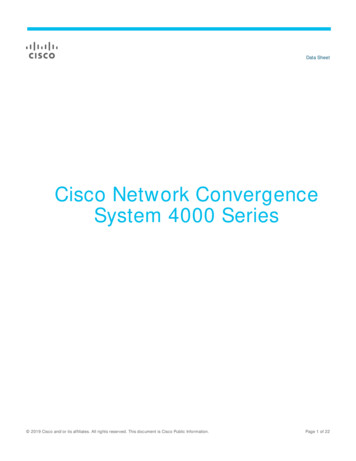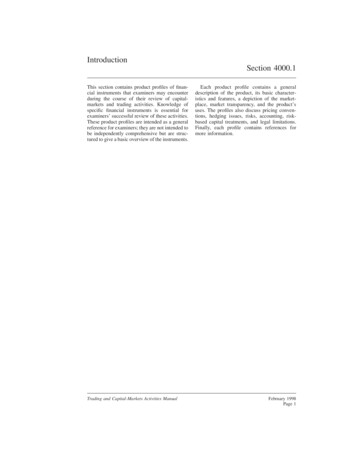
Transcription
IntroductionSection 4000.1This section contains product profiles of financial instruments that examiners may encounterduring the course of their review of capitalmarkets and trading activities. Knowledge ofspecific financial instruments is essential forexaminers’ successful review of these activities.These product profiles are intended as a generalreference for examiners; they are not intended tobe independently comprehensive but are structured to give a basic overview of the instruments.Trading and Capital-Markets Activities ManualEach product profile contains a generaldescription of the product, its basic characteristics and features, a depiction of the marketplace, market transparency, and the product’suses. The profiles also discuss pricing conventions, hedging issues, risks, accounting, riskbased capital treatments, and legal limitations.Finally, each profile contains references formore information.February 1998Page 1
Federal FundsSection 4005.1GENERAL DESCRIPTIONFederal funds (fed funds) are reserves held in abank’s Federal Reserve Bank account. If a bankholds more fed funds than is required to coverits Regulation D reserve requirement, thoseexcess reserves may be lent to another financialinstitution with an account at a Federal ReserveBank. To the borrowing institution, these fundsare fed funds purchased. To the lending institution, they are fed funds sold.CHARACTERISTICS ANDFEATURESFed funds purchases are not government-insuredand are not subject to Regulation D reserverequirements or insurance assessments. Theycan be borrowed only by those depository institutions that are required by the Monetary Control Act of 1980 to hold reserves with FederalReserve Banks: commercial banks, savingsbanks, savings and loan associations, and creditunions. These transactions generally occur without a formal, written contract, which is a uniquefeature of fed funds.Most fed funds transactions are conducted onan overnight-only basis because of the unpredictability of the amount of excess funds a bankmay have from day to day. Term fed fundsgenerally mature between two days to one year.Continuing contracts are overnight fed fundsloans that are automatically renewed unlessterminated by either the lender or the borrower—this type of arrangement is typically employedby correspondents who purchase overnight fedfunds from respondent banks. Unless notified tothe contrary by the respondent, the correspondent will continually roll the interbank depositinto fed funds, creating a longer-term instrumentof open maturity. The interest payments oncontinuing contract fed funds loans are computed from a formula based on each day’saverage fed funds rate.Fed funds transactions are usually unsecured.Nevertheless, an upstream correspondent bankthat is selling funds may require collateralization if the credit quality of the purchaser is notstrong.All fed funds transactions involve only Federal Reserve Bank accounts. Two methods areTrading and Capital-Markets Activities Manualcommonly used to transfer funds betweendepository institutions: The selling institution authorizes its districtFederal Reserve Bank to debit its reserveaccount and credit the reserve account of thebuying institution. Fedwire, the FederalReserve’s electronic funds and securities transfer network, is used to complete the transferwith immediate settlement. On the maturitydate, the buying institution uses Fedwire toreturn the funds purchased plus interest. A respondent bank tells its correspondent thatit intends to sell funds. In response, thecorrespondent bank purchases funds from therespondent by reclassifying the respondent’sdemand deposits as federal funds purchased.The respondent does not have access to itsdeposited money as long as it is classified asfederal funds on the books of the correspondents. Upon maturity of the loan, the respondent’s demand deposit account is credited forthe total value of the loan plus interest.USESBanks lend fed funds to other banks which needto meet Regulation D reserve requirements orneed additional funding sources. Since reserveaccounts do not earn interest, banks prefer tosell fed funds rather than keep higher thannecessary reserve account balances. Communitybanks generally hold overnight fed funds sold asa source of primary liquidity.DESCRIPTION OFMARKETPLACETransactions may be done directly betweenbanks, often in a correspondent relationship, orthrough brokers. They may be initiated by eitherthe buyer or the seller. Many regional banksstand ready to buy all excess funds availablefrom their community bank correspondents orsell needed funds up to a predetermined limit.Consequently, there is a large amount of demandin the fed funds market, with selling bankseasily able to dispose of all excess funds.Correspondent banks may also broker funds asagent as long as their role is fully disclosed. FedFebruary 1998Page 1
4005.1funds, including the term fed funds, are nonnegotiable products and, therefore, there is nosecondary market.Market ParticipantsParticipants in the federal funds market includecommercial banks, thrift institutions, agenciesand branches of banks in the United States,federal agencies, and government securities dealers. The participants on the buy side and sellside are the same.Federal Fundsminimal due to the short maturity. For term fedfunds, interest-rate risk may be greater, depending on the length of the term.Credit RiskFed funds sold expose the lender to credit risk.Upstream correspondent banks may require collateral to compensate for their risks. All banksshould evaluate the credit quality of any bank towhom they sell fed funds and set a maximumline for each potential counterparty.Market TransparencyPrice transparency is high. Interbank brokersdisseminate quotes on market news services.Prices of fed funds are active and visible.PRICINGFed fund yields are quoted on an add-on basis.All fed funds yields are quoted on an actual/360day basis. The fed funds rate is a key rate for themoney market because all other short-term ratesrelate to it. Bid/offer spreads may vary amonginstitutions, although the differences are usuallyslight. The fed effective rate on overnight fedfunds, the weighted average of all fed fundstransactions done in the broker’s market, ispublished in The Wall Street Journal. ThompsonBankwatch rates the general credit quality ofbanks, which is used by banks when determining credit risk for fed funds sold.Rates on term fed funds are quoted in thebroker’s market or over the counter. In addition,money market brokers publish indicative quoteson the Telerate screen.HEDGINGDue to the generally short-term nature of fedfunds, hedging does not usually occur, althoughfed funds futures contracts may be used ashedging vehicles.RISKSInterest-Rate RiskFor nonterm fed funds, interest-rate risk isFebruary 1998Page 2Liquidity RiskThe overnight market is highly liquid. As thereis no secondary market for term fed funds rates,their liquidity is directly related to their maturity.Banks may purchase fed funds up to themaximum of the line established by sellingfinancial institutions. Those lines are generallynot disclosed to purchasing banks. Active usersmay need to test the availability of funds periodically to ensure that sufficient lines are available when needed.ACCOUNTING TREATMENTFed funds sold should be recorded at cost. Termfed funds sold should be reported as a loan onthe call report.RISK-BASED CAPITALWEIGHTINGA 20 percent risk weight is appropriate for fedfunds. For specific risk weights for qualifiedtrading accounts, see section 2110.1, ‘‘CapitalAdequacy.’’LEGAL LIMITATIONS FOR BANKINVESTMENTA bank may sell overnight fed funds to anycounterparty without limit. Sales of fed fundswith maturities of one day or less or undercontinuing contract have been specificallyTrading and Capital-Markets Activities Manual
Federal Fundsexcluded from lending limit restrictions by12 CFR 32. Term fed funds are subject to the 15percent lending limit with any one counterpartyand may be combined with all other creditextensions to that counterparty. Sales of fedfunds to affiliates are subject to 12 USC 371c,‘‘Loans to Affiliates.’’4005.1Federal Reserve Bank of Richmond. Instruments of the Money Market. Richmond,Virginia. 1993.Stigum, Marcia. The Money Market. 3rd ed.Homewood, Illinois: Business One Irwin,1990.Woelfel, Charles J. Encyclopedia of Banking &Finance. 10th ed. Chicago: Probus PublishingCompany, 1994.REFERENCESFederal Reserve Bank of New York. Fedpoints#15. New York, June 1991.Trading and Capital-Markets Activities ManualFebruary 1998Page 3
Commercial PaperSection 4010.1GENERAL DESCRIPTIONCommercial paper (CP) is a short-term, fixedmaturity, unsecured promissory note issued inthe open markets as an obligation of the issuingentity. CP is usually issued with maturities ofless than 270 days, with the most commonhaving maturities of 30 to 50 days or less. CP issold either directly by the issuer or through asecurities broker. For entities with a sufficientcredit rating, CP is generally backed by banklines of credit or letters of credit. However,some entities with lesser-quality credit will issueCP without credit enhancements. These issuesare typically through private placements and aregenerally not rated. Foreign corporations mayalso issue CP. Banks are active in the CP marketas issuers, investors, dealers, and lenders onlines of credit used to back CP issuance.CHARACTERISTICS ANDFEATURESCP is issued in maturities that range anywherefrom a few days to 270 days (the Securities andExchange Commission (SEC) does not generally require registration of securities due in lessthan 270 days), depending on the funding needsof the issuer. Most CP matures in less than 30days. Issuers prefer to issue CP with a maturityof less than 90 days so that banks can use the CPas collateral at the Federal Reserve discountwindow. Most issuers need ongoing financingand roll the CP over at maturity, using the newproceeds to pay off the maturing CP. The minimum round-lot transaction is 100,000. Someissuers will sell CP in denominations of 25,000.CP is quoted on a 360-day discount basis. Asmall amount of CP is issued in interest-bearingform; the rate paid on this paper is the quoteddiscount rate converted to the equivalent simpleinterest rate. CP is typically issued in bearerform, but it may also be issued in registeredform.CP Credit RatingsCredit ratings are crucial to the CP marketbecause most investors restrict their CP investments to high-quality CP or will only buy ratedCP. The CP ratings are assessments of theissuer’s likelihood of timely payment. Table 1summarizes CP ratings from the major ratingagencies.Superior-rated issues are considered to have ahigh likelihood of repayment, satisfactory-ratedissues are considered to have satisfactory likelihood, and so on. Before they will assign a rating,the credit agencies require issuers to prove thatthey have adequate short-term liquidity. Someissuers raise their credit ratings by obtainingcredit support to guarantee payment, such as aletter of credit (credit-supported commercialpaper), or by collateralizing the issue withhigh-quality assets (asset-backed commercialpaper).USESInvestorsCP is generally purchased as a short-term,liquid, interest-bearing security. The shortTable 1—Commercial Paper ultedMoody’sS&PDuff & PhelpsP-1A-1 /A-1P-2, P-3P-3NPNPA-2A-3B, CDDuff 1, Duff 1,Duff 1 Duff 2Duff 2Duff 4Duff 5Trading and Capital-Markets Activities ManualFitchF-1F-2F-2F-3F-5April 2003Page 1
4010.1maturity structure, low credit risk, and largenumber of issuers make CP an attractive shortterm investment alternative for short-term portfolio managers and for the liquid portion oflonger-term portfolios. CP is particularly attractive when interest rates are volatile, as manyinvestors are unwilling to buy long-term, fixedrate debt in a volatile interest-rate environment.Investors wishing to take a position in shortterm rates denominated in a foreign currencywithout taking the risks of investing in anunfamiliar counterparty or facing country riskoften invest in an instrument such as GoldmanSachs’s Universal Commercial Paper (UCP) orMerrill Lynch’s Multicurrency CommercialPaper (MCCP). With UCP or MCCP, the dealercreates synthetic foreign currency–denominatedpaper by having a U.S. issuer issue CP in aforeign currency. The dealer then executes acurrency swap with the issuer, which eliminatesforeign-exchange risk for the issuer. The investor is therefore left with a short-term piece ofpaper denominated in a foreign currency andthat is issued by a U.S. counterparty, thuseliminating country risk.Banks and Bank Holding CompaniesBank holding companies (BHCs) are activeissuers of CP. The money raised is often used tofund nonbank activities in areas such as leasingand credit cards and to fund offshore branches.BHCs use commercial paper in sweep programs. On a BHC level, the sweep programs aremaintained with customers at the bank level, andthe funds are upstreamed to the parent as part ofthe BHC’s funding strategy. Sweep programsuse an agreement with the bank’s deposit customers (typically corporate accounts) that permits them to reinvest amounts in their depositaccounts above a designated level in overnightobligations of the parent bank holding company,another affiliate of the bank, or a third party.These obligations include instruments such ascommercial paper, program notes, and masternote agreements.DESCRIPTION OFMARKETPLACEInvestorsThe short-term nature of commercial paper,April 2003Page 2Commercial Papertogether with its low credit risk and largenumber of issuers, makes it an attractive shortterm investment for many investors. Investmentcompanies, especially money funds, are thelargest investors in the CP market. Other significant investors include the trust departments ofbanks, insurance companies, corporate liquidityportfolios, and state and local government bodies. If CP carries a rating of A-2, P-2, or better,thrifts may buy CP and count it as part of theirliquidity reserves.IssuersIssuers of CP include industrial companies, suchas manufacturers, public utilities, and retailers,and financial institutions, such as banks andleasing companies. Financial issuers account forapproximately 75 percent of CP outstanding,with industrial issuance making up the remainder. Approximately 75 percent of the CP outstanding carries the highest credit rating ofA-1/P-1 or better, while only approximately5 percent of CP outstanding carries a creditrating of A-3/P-3 or below. In the U.S. marketfor CP, domestic issuers account for approximately 80 percent of issuance, with foreignissuers making up the remainder.Several large finance companies and bankholding companies place their paper directlywith the investor without using a dealer.Approximately 40 percent of all CP outstandingis placed directly with the investor.Primary MarketThe primary market consists of CP sold directlyby issuers (direct paper) or sold through a dealeracting as principal (dealer paper). Dealer paperaccounts for most of the market. As principals,dealers buy and immediately sell the CP (with asmall markup called the dealer spread). Sometimes the dealers hold CP as inventory for ashort time as a service to issuers in need ofimmediate funds. Dealers are mostly large investment banks and commercial banks with subsidiaries that underwrite and deal in securities.Although dealers do not normally inventorypositions in CP, at times they will agree toposition any paper that the issuer posted but didnot sell on a particular day. The amount unsoldis usually small, and the positions assumed areTrading and Capital-Markets Activities Manual
Commercial Paper4010.1usually on an overnight basis only. If the marketmoves, most issuers give dealers the discretionto sell CP within established bands set by theissuer.Issuers of CP have their own dedicated salesforce to market their paper. Direct issuers alsopost their rates on services such as Telerate andReuters and often post rates with bank moneydesks. Sometimes a company sells direct paperunder a master-note agreement, under which theinvestor can buy and sell CP daily, up to aspecific amount, for a specific interest rate that isset daily. The return on the master-note CP isslightly higher than that on an overnight repo.HEDGINGSecondary MarketRISKSAs mentioned above, dealers do not usuallyinventory positions in CP. When they do, thesepositions tend to be small and are usually heldonly overnight. Because of the short-term natureof CP, dealers often do not hedge these openpositions. When these positions are hedged,dealers generally use instruments such as T-billfutures or Eurodollar futures to hedge theirresidual exposure. However, use of these products may subject the dealer to basis risk to theextent that the underlying instrument and thehedge instrument do not move in tandem.Credit RiskThe CP market is larger than the market forother money market instruments, but secondarytrading is only moderately active. Most investors have purchased CP tailored to their shortterm investment needs and hold it to maturity. Ifan investor chooses to sell CP, he can usuallysell it back to the original seller (dealer orissuer). Although CP is not traded on an organized exchange, price quotes for most of thesignificant issues can be obtained from securitybrokers. Average yields on newly issued CP arepublished in the Wall Street Journal.Given that CP is an unsecured obligation of theissuer, the purchaser assumes the risk that theissuer will not be able to pay the debt atmaturity. This credit risk is generally mitigatedby the financial strength of most issuers and bysome form of credit enhancement (unused banklines of credit, letters of credit, corporate guarantees, or asset collateralization). Historically,the default rate on CP has been extremely low.Liquidity RiskPRICINGEach issue is priced based on the strength of thecredit rating of the issuer. CP is a discountinstrument, which means that it is sold at a priceless than its maturity value (though occasionally, CP is issued as interest-bearing paper). Thedifference between the maturity value and theprice paid is the interest earned by the investor.When calculating commercial paper, a year isassumed to have 360 days.The yield on CP tracks that of other moneymarket instruments. CP yields are higher thanthose offered on comparable T-bills—the highercredit risk is due to less liquidity and the stateand local income tax exemption of T-bills. Therate on CP is also slightly higher than thatoffered on comparable certificates of deposit(CDs) due to the poorer liquidity of CP relativeto CDs.Trading and Capital-Markets Activities ManualAs most investors hold CP until maturity, trading in the secondary market is relatively thin. Asa result, only the highest-rated issues may bereadily marketable in the secondary market.Privately placed CP is subject to further legallymandated restrictions on resale, which presentsadditional impediments to marketability.Interest-Rate RiskLike all fixed-income instruments, CP is subjectto interest-rate risk. However, this risk is usuallyminimal given CP’s short-term nature.Foreign-Exchange RiskCP denominated in foreign currency may exposethe purchaser to foreign-exchange risk.April 2003Page 3
4010.1ACCOUNTING TREATMENTThe accounting treatment for investments incommercial paper is determined by the Financial Accounting Standards Board’s Statement ofFinancial Accounting Standards No. 140 (FAS140), ‘‘Accounting for Transfers and Servicingof Financial Assets and Extinguishments ofLiabilities.’’ Accounting treatment for derivatives used as investments or for hedging purposes is determined by Statement of FinancialAccounting Standards No. 133 (FAS 133),‘‘Accounting for Derivatives and HedgingActivities,’’ as amended by Statement of Financial Accounting Standards Nos. 137 and 138(FAS 137 and FAS 138). (See section 2120.1,‘‘Accounting,’’ for further discussion.)RISK-BASED CAPITALWEIGHTINGCP is generally weighted at 100 percent unless itis backed by a bank letter of credit, in whichcase the asset weight would be 20 percent.Tax-exempt CP may carry weights of 20 percentor 50 percent, depending on the issuer (that is,depending on whether the obligation is a generalobligation or a revenue obligation). For specificrisk weights for qualified trading accounts, seesection 2110.1, ‘‘Capital Adequacy.’’April 2003Page 4Commercial PaperLEGAL LIMITATIONS FOR BANKINVESTMENTCP is considered a loan to the issuer and istherefore subject to the applicable lending limitof the purchasing institution. One exceptionwould be general obligation tax-exempt CP,which can be held without limitation. Holdingsof CP issued by an affiliate are subject to thelimitations of section 23A of the Federal ReserveAct regarding loans to affiliates.REFERENCESFabozzi, Frank J., and T. Dessa, eds. The Handbook of Fixed Income Securities. 4th ed.Chicago: Irwin Professional Publishing, 1995.Hahn, Thomas K. ‘‘Commercial Paper.’’ Economic Quarterly 29(1993): 45–67.Stigum, Marcia. After the Trade. Burr Ridge,Ill.: Dow Jones-Irwin, 1988.Stigum, Marcia. The Money Market. 3rd ed.Burr Ridge, Ill.: Irwin Professional Publishing, 1990.Trading and Capital-Markets Activities Manual
Repurchase AgreementsSection 4015.1GENERAL DESCRIPTIONA repurchase agreement (repo) involves the saleof a security to a counterparty with an agreement to repurchase it at a fixed price on anestablished future date. At initiation of thetransaction, the buyer pays the principal amountto the seller, and the security is transferred to thepossession of the buyer. At expiration of therepo, the principal amount is returned to theinitial buyer (or lender) and possession of thesecurity reverts to the initial seller (or borrower).Importantly, the security serves as collateralagainst the obligation of the borrower and doesnot actually become the property of the lender.Given the short tenor of a typical repo and theneed to make proper custody arrangements forthe securities involved, operational issues areimportant to proper management of repo activities. At times, in addition to being a counterparty in some transactions, a bank may serve asthird-party custodian of securities collateral inother transactions as a service to the buyer andthe seller.In a repurchase agreement, a bank borrowsfunds when it ‘‘sells’’ the security and commitsto ‘‘repurchase’’ it in the future. In a reverserepurchase agreement, the bank lends fundswhen it ‘‘buys’’ the security and commits to‘‘resell’’ it in the future. A reverse repo issometimes termed a resale agreement or a security purchased under agreement to resell (SPAR).The terms ‘‘repo’’ and ‘‘reverse repo’’ thusdescribe the same transaction, but from theperspective of each counterparty.A closely related instrument is a dollar roll,which is identical to a repurchase agreementexcept that the ‘‘repurchase’’ leg of the transaction may involve a similar security rather thanthe specific security initially ‘‘sold.’’ In a dollarroll, the transaction contract explicitly allowsfor substitution of the collateral. The borrowerof funds in this transaction thus runs the risk thatat the closing of the transaction he or she willown a security that is generally comparable butinferior in some material way to the originalsecurity.CHARACTERISTICS ANDFEATURESMost repos are conducted with U.S. Treasury orTrading and Capital-Markets Activities Manualagency securities as collateral. Repos of mortgage pass-through securities and collateralizedmortgage obligations (CMOs) issued or guaranteed by U.S. government agencies are less common but occur frequently. Repos of other securities or loans are not common, in part becausethe Federal Reserve System generally considersrepos with other assets to be deposits of theselling institution and subject to Regulation Dreserve requirements.Repos can be conducted on an overnightbasis, for a longer fixed term, or on an openaccount basis. Overnight repos, or one-day transactions, represent approximately 80 percent ofall repo transactions. Anything longer (called a‘‘term repo’’) usually extends for less than30 days. Repo agreements ‘‘to maturity’’ arethose that mature on the same day as theunderlying securities. ‘‘Open’’ repo agreementshave no specific maturity, so either party has theright to close the transaction at any time.USESIn general, repos are attractive to a variety ofmarket participants as (1) a low-cost source ofshort-term funding for borrowers and (2) anasset with high credit quality regardless of thecounterparty for suppliers of funds. Participationin this market requires proper operational andadministrative arrangements as well as an inventory of eligible collateral.DealersRepos can be used to finance long positions indealers’ portfolios by short-term borrowing. Therepo market is a highly liquid and efficientmarket for funding dealers’ bond inventory at ashort-term rate of interest. Dealers may also userepos to speculate on future levels of interestrates. The difference between the coupon rate onthe dealer’s bond and the repo rate paid by thedealer is called ‘‘carry,’’ and it can be a source ofdealer profit. Sometimes the borrowing rate willbe below the bond’s coupon rate (positive carry),and sometimes the borrowing rate will be abovethe bond’s coupon rate (negative carry).Dealers may use reverse repos to cover shortpositions or failed transactions. The advantageApril 2001Page 1
4015.1of the reverse repo is that a dealer may borrowa security it has sold short with either positive ornegative carry. A problem arises, however, whendemand exceeds supply for a specific bond issue(collateral), and it goes on ‘‘special.’’ Thismeans that those who own the security can earna premium by lending it to those needing todeliver on short positions. These ‘‘lenders’’ arecompensated by paying a below-market borrowing rate on the cash side of the transaction (therepo rate is lower on ‘‘specials’’ because theowner of the special security is the borrower ofcash funds and is seeking the lowest lending ratepossible).Bank Nondealer ActivityLike dealers, a bank can use repos to fund longpositions and profit from the carry. The marketalso gives a bank the means to use its securitiesportfolio to obtain additional liquidity—that is,funding—without liquidating its investments orrecognizing a gain or loss on the transaction. Formoney market participants with excess funds toinvest in the short term, reverse repos provide acollateralized lending vehicle offering a betteryield than comparable time deposit instruments.Commercial DepositorsRepos have proved to be popular temporaryinvestment vehicles for individuals, firms, andgovernments with unpredictable cash flows.Repos (like other money market instruments)can also be used as a destination investment forcommercial depositors with sweep accounts,that is, transaction accounts in which excessbalances are ‘‘swept’’ into higher-yielding nonbank instruments overnight. Again, as collateralfor the corporation’s investment, the counterparty or bank will ‘‘sell’’ Treasury bills to thecustomer (that is, collateralize the loan).DESCRIPTION OFMARKETPLACEOn any given day, the volume of repo transactions amounts to an estimated 1 trillion. Important lenders of funds in the market include largecorporations (for example, General Motors) andmutual funds. Borrowers generally include largeApril 2001Page 2Repurchase Agreementsmoney-center or regional banks with a need forfunding.Repos are not traded on organized exchanges.There is no secondary market, and quoted market values are not available. The Public Securities Association has produced a standard masterrepo agreement and supplements that are usedthroughout the industry. Although the transactions themselves are not rated, the entitiesundertaking repos (such as larger banks anddealers) may be rated by Moody’s, Standard &Poor’s, or other rating agencies.PRICINGRepo rates may vary somewhat with the type ofcollateral and the term of the transaction. Overnight repos with U.S. government collateral,however, generally take place at rates slightlybelow the federal funds rate. Interest may bepaid explicitly, so that the ‘‘sale’’ price and‘‘repurchase’’ price of the security are the same,or it may be embedded in a difference betweenthe sale price and repurchase price.The seller of a security under a repo agreement continues to receive all interest and principal payments on the security while the purchaser receives a fixed rate of interest on ashort-term investment. In this respect, interestrates on overnight repo agreements usually arelower than the federal funds rate by as much as25 basis points. The additional security providedby the loan collateral employed with reposlessens their risk relative to federal funds.Interest is calculated on an actual/360 daycount add-on basis. When executed under acontinuing contract (known as a demand oropen-basis overnight repo), repo contracts usually contain a clause to adjust the interest rate ona day-to-day basis.HEDGINGSince repo rates move closely with those ofother short-term instruments, the hedge vehiclesavailable for these other instruments offer anattractive hedge for positions in repos. If theportfolio of repos is not maintained as a matchedbook by the institution, the dealer or bank couldbe subject to a level of residual market risk.Trading and Capital-Markets Activities Manual
Repurchase Agreements4015.1RISKSACCOUNTING TREATMENTMarket RiskThe accounting treatment for repurchase agreements is determined by the Financial Accounting Standards Board’s Statement of FinancialAccounting Standards No. 140 (FAS 140),‘‘Accounting for Transfers and Servicing ofFinancial Assets and Extinguishments of Liabilities.’’ Accounting treatment for derivatives usedas investments or for hedging purposes is determined by Statement of Financial AccountingStandards No. 133 (FAS 133), ‘‘Accounti
Market Transparency Price transparency is high. Interbank brokers disseminate quotes on market news services. Prices of fed funds are active and visible. PRICING Fed fund yields are quoted on an add-on basis. All fed funds yields are quoted on an actual/360-day basis. The fed funds rate is a key rate for the money market because all other short .

